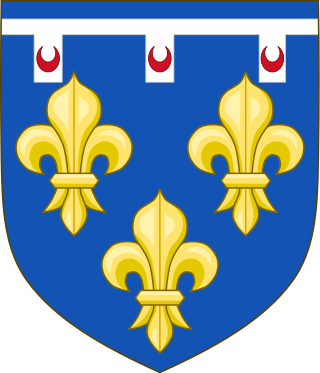Top Qs
Timeline
Chat
Perspective
Counts and Dukes of Angoulême
Rulers of Angoulême From Wikipedia, the free encyclopedia
Remove ads
Angoulême (L'Angoumois) in western France was part of the Carolingian Kingdom of Aquitaine. Under Charlemagne's successors, the local count of Angoulême was independent and the county was not united with the French crown until 1308. By the terms of the Treaty of Brétigny (1360) the Angoumois, then ruled by the counts of Angoulême, was ceded to King Edward III of England. In 1371 it became a fief of Duke John of Berry and then passed to Duke Louis I of Orleans, both of whom were cadets of the French royal family. From then on it was held by cadets of the Valois House of Orleans, until Francis of Angoulême, became king of France in 1515. Angoumois was definitively incorporated into the French crown lands, as a duchy.
Remove ads
Counts of Angoulême
House of Guilhelmides
- Turpio (839–863)[1]
- Emenon of Poitiers (863–866),[2] brother of Turpio
- Aymer of Poitiers (Aymer I of Angoulême) (916–926),[3] son of Emenon
House of Taillefer

- Wulgrin I (866–886),[4] first hereditary count, appointed by Charles the Bald
- Alduin I (886–916),[5] son of Wulgrin I
- William II ("Taillefer" I) (926–c.945),[6] son of Alduin I
- Aymer II (after 945–before 952),[7] son of William II (Taillefer I)
- Bernard (after 945–before 952),[8] son of William I (William I is the son of Wulgrin I and brother to Alduin I)
- Arnald I "Voratio" (after 950–before 952),[9] son of Bernard
- William III Talleyrand (952– 962),[10] son of Bernard
- Rannulf "Bompar" (962–975),[11] son of Bernard
- Richard the Simple (975?),[12] son of Bernard
- Arnald II "Manzer" (975–988),[13] son of William II (Taillefer I)
- William IV (Taillefer II) (988–1028),[14] son of Arnald II
- Alduin (II) (1028–1031),[15] son of William IV (Taillefer II)
- Geoffrey (1031–1047),[16] son of William IV (Taillefer II)
- Fulk (1047–1087),[17] son of Geoffrey
- William V (Taillefer III) (1087–1120),[18] son of Fulk
- Wulgrin II (1120–1140),[19] son of William V (Taillefer III)
- William VI (Taillefer IV) (1140–1179),[20] son of Wulgrin II
- Wulgrin III (1179–1181),[21] son of William VI (Taillefer IV)
- William VII (Taillefer V) (1181–1186),[22] son of William VI (Taillefer IV)
- Aymer III (1186–1202),[23] son of William VI (Taillefer IV)
- Isabella (1202–1246),[24] daughter of Aymer III
- John of England (House of Plantagenet) (1202–1216), first husband of Isabella
- Hugh X of Lusignan (House of Lusignan, see below) (1220–1249), second husband of Isabella
House of Lusignan

- Hugh X of Lusignan (Hugh I of Angoulême) (1219–1249).[25] His father, Hugh IX of Lusignan, was married to Mathilde of Angoulême, daughter of Wulgrin III Taillefer (see above)
- Hugh XI of Lusignan (II of Angoulême) (1246–1250)
- Hugh XII of Lusignan (III of Angoulême) (1250–1270)
- Hugh XIII of Lusignan (IV of Angoulême) (1270–1303)
- Guy (1303–1308)
- Part of Aquitaine (1308–1317)
- Royal Domain (1317–1328)
Royal Grantees
- Joan (1328–1349) House of Capet, with her husband, Philip III of Navarre. House of Évreux
- Philip (1328–1343) House of Évreux
- Charles de La Cerda (1350–1354) House of La Cerda
- John I (1356–1374) House of Valois
- Louis I (1404–1407), Duke of Orléans. House of Valois-Orléans
- John II (1407–1467) House of Valois-Orléans-Angoulême
- Charles (1459–1496) House of Valois-Orléans-Angoulême
- Francis (1496–1515) House of Valois-Orléans-Angoulême
Remove ads
Dukes of Angoulême

- Louise (1515–1531)
- Royal domain
- Charles (1540–1545)
- Royal domain
- Charles (1550)
- Henry (1551–1574)
- Henry (1574–1582)
- Diane (1582–1619)
- Charles (1619–1650)
- Louis Emmanuel (1650–1653)
- Frances Marie (1653–1696)
- Louis II (1653–1654)
- Royal domain
- Élisabeth Marguerite d'Orléans (1675–1696)
- Royal domain
- Charles de France (1710–1714)
- Royal domain
- Charles Philippe de France (1773–1836)
- Louis Antoine d'Artois (1836–1844)
- Royal domain
Remove ads
Duchesses of Angoulême
- Louise of Savoy (1476–1531) - wife of Charles, Count of Angoulême from 1488.
- Marie Thérèse of France (1778–1851) - wife of Louis Antoine from 1799.
Sources
Further reading
Wikiwand - on
Seamless Wikipedia browsing. On steroids.
Remove ads